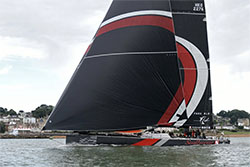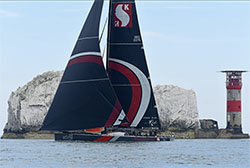 COWES, England – Lee Seng Huang's 100-foot maxi SHK Scallywag entered the history books today by winning line honors in the Transatlantic Race 2019. This accolade continues a prestigious, ancient lineage started by James Gordon Bennett Jr.’s Henrietta in 1866 and since including Charlie Barr on Wilson Marshall’s record setting three-masted schooner Atlantic in 1905 to a century later, Robert Miller’s Mari Cha IV, winner of the Rolex Transatlantic Race in 2005. The New York Yacht Club organized the first race in 1866 and this year was joined by the Royal Yacht Squadron, Royal Ocean Racing Club and the Storm Trysail Club.
COWES, England – Lee Seng Huang's 100-foot maxi SHK Scallywag entered the history books today by winning line honors in the Transatlantic Race 2019. This accolade continues a prestigious, ancient lineage started by James Gordon Bennett Jr.’s Henrietta in 1866 and since including Charlie Barr on Wilson Marshall’s record setting three-masted schooner Atlantic in 1905 to a century later, Robert Miller’s Mari Cha IV, winner of the Rolex Transatlantic Race in 2005. The New York Yacht Club organized the first race in 1866 and this year was joined by the Royal Yacht Squadron, Royal Ocean Racing Club and the Storm Trysail Club.
The Andy Dovell-designed maxi crossed the Royal Yacht Squadron line off Cowes this afternoon at 17:43:19 UTC in a passage time of 10 days, 2 hours, 13 minutes and 19 seconds. Skippered by David Witt, the Australian now living in Hong Kong, SHK Scallywag’s crew included Anniemeike Bes (Haarlem, the Netherlands), Lucas Chapman (The Junction, Australia), Tom Clout (Sydney, Australia), Nick Crones (Sydney, Australia), Pete Cumming (Warsash, U.K.), Ian Flemming (Hong Kong), Ferdinand Galleta (Bauang, Philippines), Alex Gough (Brisbane, Australia), Jack Mcartney (Paddington, Australia), Ben Piggott (Thirrol, Australia), Trystan Seal (Cilcennin, Wales), Miles Seddon (Lymington, U.K.) and Charlie Wyatt (Brisbane, Australia).
If there were any records for this year’s race it was for the slow pace as the leaders found themselves having to take dramatic detours to avoid windless high-pressure systems. In the race’s last edition in 2015 Jim and Kristy Clarke’s 100-foot maxi Comanche won line honors in 7 days, 11 hours, and 35 minutes, and that was also considered a relatively slow race.
For skipper Witt, a modern day Samuel Samuels (Gordon Bennett’s skipper in 1866), the concern was making it across. “It comes with some relief. At one point it didn’t look like we were going to make it,” Witt said.
Shortly after rounding A3, the southeastern-most point of the Point Alpha ice exclusion zone, SHK Scallywag found herself nailed by prolonged gale force winds. As British navigator Miles Seddon describes: “The sea state wasn’t that bad, it was probably 2 to 2.5 meters (six to eight feet) with the occasional 3-meter wave (nine feet), but we just got caught too close to the center of the low, between the cold front closing up on the warm front. The forecast was for 25 knots max and we were prepared for gusts of probably 32, but there we were, sailing along in 42. In 42 knots things are flying around the boat and you end up on the back foot because things get damaged.”
The crew couldn't reef the mainsail beyond the second reef point because a bolt at the top of the towering, 41-meter (134-foot) mast had started to protrude and was preventing the crew from reducing sail beyond the second reef point.
“A $3 bolt almost destroyed a $3 million mainsail,” Witt said.
Under normal circumstances they might have turned and run with the gale to reduce apparent wind, but this would have taken them into the ice exclusion zone. “We were on the ice gate, it was like being pinned to a lee shore,” observed Witt.
Unwilling to retire, all they could do in the circumstances was to go into survival mode and sail with the main feathering until the severe winds passed. Thus, the SHK Scallywag crew battened down hatches, left two people on deck and rather than follow the big wind, let them move away. According to Witt the gale force winds lasted for almost 18 hours, but it was almost another three days before the wind had reduced enough, to 10 to 12 knots, for them safely to haul someone to the top of the giant spar and release the sail.
“It has been good for us,” Witt said generally of his Transatlantic Race 2019 experience. “The biggest problem with a 100-footer is reliability. The 70s [he refers to their competition, the VO70 Wizard, which previously won the Volvo Ocean Race as Groupama 4] have been around the world. The longest race 100-footers typically do is the Sydney to Hobart, which is 600 miles.” The Transatlantic Race 2019 was by far SHK Scallywag’s longest race to date.
During the big winds SHK Scallywag also damaged her largest jib, the J1 when it was washed overboard while hanked on. This incident also destroyed some of the forward stanchions. According to Seddon they also took some waves that caused their tracker to become water-logged and inoperable and they also temporarily wiped out their satellite communications, although they subsequently managed to repair this.
Once back up to speed SHK Scallywag was able to make good use of the conditions prior to negotiating the top of the high pressure. In this period their top 24-hour run was 505 miles.
Witt paid tribute to the Wizard crew, who against expectation (due to having a 30-foot shorter boat) led for the majority of the Transatlantic Race 2019. “They will win under IRC and they deserve to win that. You have to realize that in 40-plus knots, you’d much rather be on a VO70. We were lucky we didn’t give up. It was only when the breeze dropped that we could catch up,” said Witt.
 For Seddon, this year’s slow race came after a comparatively rip-roaring ride across four years ago on the 70-foot trimaran Phaedo in a time of just over seven days. “It is very nice to be here,” he said upon finishing. “It felt like it went on for longer than eternity! We tried to throw it away a few times. It was beautiful sailing conditions to begin with, heinous survival mode in the middle and playing catch up again. It was certainly a long one.”
For Seddon, this year’s slow race came after a comparatively rip-roaring ride across four years ago on the 70-foot trimaran Phaedo in a time of just over seven days. “It is very nice to be here,” he said upon finishing. “It felt like it went on for longer than eternity! We tried to throw it away a few times. It was beautiful sailing conditions to begin with, heinous survival mode in the middle and playing catch up again. It was certainly a long one.”
Back up in fighting mode, SHK Scallywag eventually passed Wizard for a second time approaching the Scilly Isles and then basked in the light upwind conditions of the last 48 hours when they could make full use of their towering sail plan and their waterline length advantage.
SHK Scallywag dealt with an ultra-light-wind English Channel and its present strong tides remarkably well. “The only time we got slowed down was between Portland Bill and Anvil Point,” explained Seddon. “The change of tide killed the wind and the cloud cover stopped the sea breeze from developing. So we had to wait, anchor at the ready.” In fact in the half hour it took for them to ready the anchor, the first signs of a new breeze filling in were already evident.
This afternoon there was enough wind to get them through Hurst Narrows at the western end of the Solent despite their having to punch into 4.5 knots of adverse current. “In 8 to 10 knots of wind we are doing 13 knots through the water, so it didn’t affect us too badly. We knew we’d get through it,” said Seddon.
There is no rest for the wicked. Witt and the SHK Scallywag crew are off to the Philippines now to race their trimaran in Japan before they are reunited with their 100-foot maxi for the Royal Ocean Racing Club’s Rolex Fastnet Race on Aug. 3.
